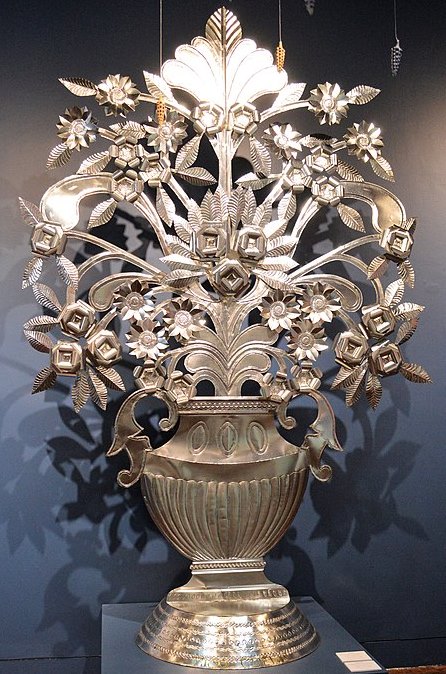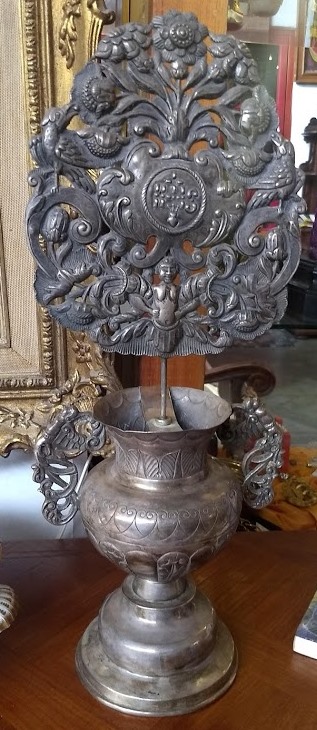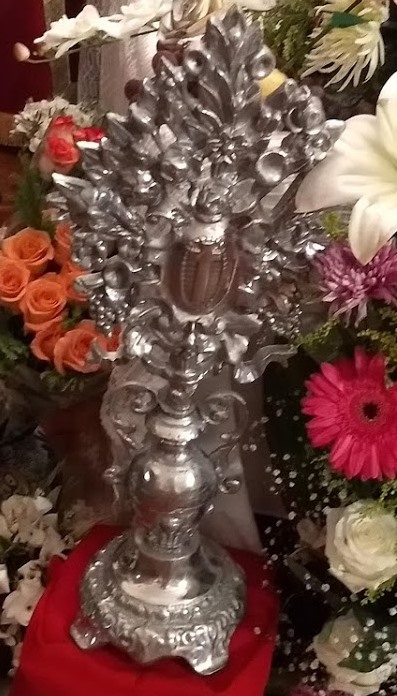Apparently quite a bit as I was recently reminded when investigating the origins of antique religious art featured around town but often overlooked.
While taking a tour group through an old hacienda in Guanajuato a dimly lit stairwell featured a kayak paddle shaped and sized art where the stairs changed directions. Made of silver from local mines the art made a handy thing to grab when switching directions to continue up and down. “How odd” I thought “As this type of art is normally only seen on altars.”
Three days later I’m at a rosary for when Mary goes to sleep before continuing her journey of being lifted up into Heaven by angels. The altar is laced with symbolism as surrounding the Colonial Era image of Mary is fruit, representing how San Miguel had long been surrounded by orchards. Each apple (for Eve’s original sin) featured a blue or pink flower for the colors of angels and where we get the pink and blue for baby nurseries from. In each flower was a blessing from Mary for you as you left the party later that evening following tamales and music.
Also on the altar were two pairs of the kayak paddle shaped and sized art from the mid to late 1800s laced with flowers and fruit. “What are those?” I pondered as I’ve seen them on altars around town and on the stairwell a few days prior.
They are called palmatorias and I was instantly confused and stayed so as I asked around.
Palmatoria means candlestick but this art had no place to put candles so that can’t be right. The art also has no place to put a relic thus ruling out being a reliquary as many suggested. Plus there was no space to put a communion wafer so being a monstrance was out of the question. Others felt they were a Tree of Life depicting the beginning of the world to present day. Candlestick, reliquary, Tree of Life and monstrance were all good guesses but not quite right to describe these Palmatorias.
At the same time I learned how a Palmatoria is also a type of kayak(ish) paddle. Namely one used in Catholic schools to administer spankings popular throughout Europe for centuries and used in Spain into the 1980s.

Wow, did that open a Pandora’s Box of memories on-line! I received messages in great detail of being beat in Catholic school I knew I was on the wrong path. First off, the brides of Christ in Hershey, Pa came from German stock and they were nothing if not frugal. No special made paddle for them as one was simply smacked upside the head by a text book. I often pondered if that was the first time Sr. Mary of Perpetual Pain even picked up the book she taught from.
Plus the palmatorias here were made from silver or ore, so they’re heavy and not easily lifted to administer a smack. Not to mention they are finely sculptured art.
For the record don’t google palmatoria plus paddle. You’ll quickly find yourself in the dark web of sexual fetishes. Again, obviously, I’m on the wrong path.
Visiting local antique shops I learned a decorative Palmatoria has been around since the time of Christ and were featured in temples since back when he was in said temples. They appear to have no utilitarian purpose other than beauty particularly when the church was unable to access actual flowers.

Leticia Fernandez de Noyola, owner of La Buhardilla antiques in the Fabrica clued me in how the term palmatoria came from the ability to fit the base on the art in the palm of your hand.
Made from most any material here they tend to be silversmithed engravings reaching their zenith of popularity here in the mid to late 19th century. An individual palmatoria can cost thousands of US dollars though they tend to come in pairs and are featured in art museums throughout Mexico.
Still I’m on the lookout for a cheaper version of a palmatoria. Not for an altar but, rather, knowing if I live long enough the stairwell in my home will vex me and having an ancient art form to hold on to could actually be life-affirming.
By Joseph Toone



